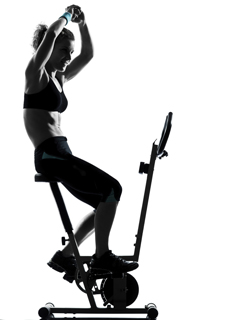Commonly Used Indoor Cycling Terms

If you are new to indoor cycling, but plan to start this winter, it is important to familiarize yourself with the most commonly used indoor cycling terms. Whether you are taking a class, working out with a personal trainer, or reading about tips and workouts from resources online, you need to understand these terms if you are to get the most out of your training.
Flat
When cycling outdoors, the word "flat" obviously refers to any road or track without an incline; therefore, it may initially seem as if all indoor cycling is flat, so it can be confusing when you come across the term in your workout. As flat stretches tend to be easier than hill climbs, you could draw the wrong conclusion that "flat" in indoor cycling refers to easy stretches of the workout. However, flat can be any intensity: easy, moderate, hard, and even all-out effort.
Most often, flat stretches outdoors are taken in a seated position, the exception being when the cyclist wants to increase power, perhaps in order to pass another ride or cross an intersection, or just when he or she wants a break from sitting in the saddle. The same goes for indoor cycling; you will want to sit for the duration of any flat sections of your workout.
Hill
Although the terrain below the indoor bike never changes, the workout can still include hill climbs just as it does flat sections. As you know, flat sections are seated; conversely, hill climbs usually consist of coming out of the saddle. However, you can also reproduce the sensation of climbing a hill with indoor cycling by increasing the resistance of your indoor bike for a high effort, seated hill climb.
Resistance
Also called tension or gear, resistance is controlled with a lever or a knob usually on the handlebars or between your knees. When you move the lever or knob to the right, the resistance increases and makes it more difficult to pedal. Shifting the lever or knob to the left removes some of the resistance and makes pedaling easier. Some indoor bike trainers, such as rollers, do not allow you to change the resistance. If you are able to control resistance, take advantage of this feature to modulate the difficulty of your workout.
RPM
RPM stands for revolutions per minute and refers to the number of times that you turn one pedal completely over the span of a minute. In outdoor cycling, RPM is typically between 50 and 110, with the majority of the work happening between 60 and 99 RPM, according to the American Council on Exercise (ACE). You can determine your RPM by installing a device on your bike's handlebars or by matching the rhythm of your instructor or coach. In some classes, you will be told to cycle at the tempo of a song, although this makes it difficult to determine the RPM of sprints.
Though by no means an exhaustive list, these terms are some of the most common found in indoor cycling. Do you think we missed any? If so, chime in; we’d love to hear your input!

